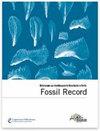A giant mite in Cretaceous Burmese amber
IF 2.1
4区 地球科学
Q1 PALEONTOLOGY
引用次数: 3
Abstract
Abstract. An unusually large acariform mite is described as Immensmaris chewbaccei gen. et sp. nov. from the Cretaceous (ca. 100 Ma) Burmese amber of Myanmar. With an idiosoma plus gnathosoma more than a centimetre long, it represents the largest unequivocal fossil mite ever recorded and approaches the maximum size of the largest living Acariformes today. Although some details of the dorsal idiosoma are equivocal, the new fossil appears to belong to Smarididae (Prostigmata: Parasitengona: Erythraeoidea) and also represents the largest erythraeoid mite ever discovered, indicating a clade of giant, possibly arboreal, mites in the Late Cretaceous of southeastern Asia.白垩纪缅甸琥珀中的巨型螨虫
摘要缅甸白垩纪(约100 Ma)缅甸琥珀中的一种异常大的针状螨被描述为imunsmarischewbacei gen. et sp. 11 .。它有一个超过1厘米长的独特体和颌体,代表了有史以来最大的明确化石螨,接近当今最大的活螨的最大尺寸。虽然背部特有体的一些细节尚不清楚,但新化石似乎属于Smarididae (prostimata: Parasitengona:Erythraeoidea),也代表了迄今为止发现的最大的erythraeoid螨,表明东南亚晚白垩世的一个巨大的,可能是树栖的螨类。
本文章由计算机程序翻译,如有差异,请以英文原文为准。
求助全文
约1分钟内获得全文
求助全文
来源期刊

Fossil Record
PALEONTOLOGY-
CiteScore
3.60
自引率
7.10%
发文量
18
审稿时长
14 weeks
期刊介绍:
Fossil Record (FR) is the palaeontological journal of the Museum für Naturkunde Berlin. This journal was founded in 1998 under the name Mitteilungen aus dem Museum für Naturkunde Berlin, Geowissenschaftliche Reihe and appears with two issues each year. Fossil Record publishes original papers in all areas of palaeontology including the taxonomy and systematics of fossil organisms, biostratigraphy, palaeoecology, and evolution. All taxonomic groups are treated, including invertebrates, microfossils, plants, and vertebrates.
 求助内容:
求助内容: 应助结果提醒方式:
应助结果提醒方式:


